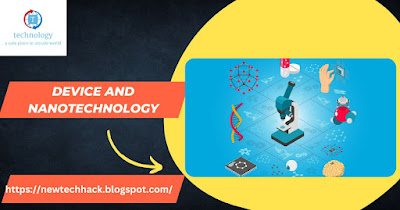Device and nanotechnology
are interconnected fields that have revolutionized various industries and enabled the development of smaller, faster, and more efficient electronic devices. Nanotechnology involves the manipulation and control of matter at the nanoscale, typically between 1 and 100 nanometers, to create new materials and devices with unique properties.
- The integration of nanotechnology into electronic devices has resulted in significant advancements. Here are some key aspects of device and nanotechnology:
- Miniaturization: Nanotechnology has played a crucial role in the miniaturization of electronic devices. As the size of transistors and components decreases, more devices can be packed into smaller spaces, leading to the development of portable and wearable devices such as smartphones, smartwatches, and fitness trackers. Nanoscale materials and structures enable the fabrication of smaller, more efficient electronic components.
- Improved Performance: Nanoscale materials and structures exhibit unique properties that can enhance the performance of electronic devices. For example, carbon nanotubes and graphene offer exceptional electrical conductivity and mechanical strength, making them ideal for applications such as flexible displays and high-speed transistors. Nanotechnology enables the precise control and manipulation of materials at the atomic and molecular level, allowing for the development of devices with improved energy efficiency, faster processing speeds, and higher storage capacities.
- Energy Efficiency: Device and nanotechnology have contributed to significant improvements in energy efficiency. Nanoscale materials can be engineered to have reduced power consumption and enhanced energy storage capabilities. For instance, nanoscale lithium-ion batteries provide higher energy densities and longer battery life for portable electronic devices. Nanotechnology also enables the development of energy-efficient light-emitting diodes (LEDs), which consume less power and have longer lifespans compared to traditional lighting technologies.
- Sensing and Biomedical Applications: Nanotechnology has found applications in sensors and biomedical devices. Nanosensors can detect and measure physical, chemical, and biological phenomena with high sensitivity and selectivity. These sensors are utilized in various fields, including environmental monitoring, healthcare diagnostics, and food safety. Nanotechnology also enables the development of targeted drug delivery systems, biosensors, and bioimaging techniques, revolutionizing the field of medicine.
- Emerging Technologies: Device and nanotechnology continue to drive the development of emerging technologies. For example, quantum dots, which are nanoscale semiconductor crystals, have unique optical properties and are used in displays, solar cells, and quantum computing. Nanoscale memory technologies, such as resistive random-access memory (RRAM) and phase-change memory (PCM), offer fast, non-volatile storage capabilities that can outperform traditional memory technologies.
However, there are also challenges associated with device and nanotechnology, including scalability, manufacturing processes, and potential environmental and health impacts of nanomaterials. Continued research and development are necessary to address these challenges and ensure the safe and responsible implementation of nanotechnology in devices.
In conclusion, device and nanotechnology have significantly impacted various industries by enabling miniaturization, improving device performance and energy efficiency, facilitating sensing and biomedical applications, and driving the development of emerging technologies. These advancements continue to shape our modern world and hold great potential for future innovations.






No comments:
Post a Comment